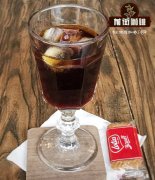Coffee beans at White Nile washing Station in Nebbi, Uganda. How to make Ugandan coffee?

Professional coffee knowledge exchange more coffee bean information please follow the coffee workshop (Wechat official account cafe_style)
When it comes to boutique coffee, it can be said that African beans have emerged as a new force in recent years, and they have performed well in the evaluation of many coffee beans. It is also recognized and liked by more and more people. However, perhaps when it comes to African beans, we have more feedback from Ethiopia and Kenya, while smaller ones such as Rwanda and Uganda also have their own unique charm. Let's talk about Ugandan coffee beans today.
Uganda is a landlocked country located in eastern Africa and across the equator. It is bordered by Kenya to the east, Tanzania and Rwanda to the south, Congo to the west and South Sudan to the north, with a total area of 241500 square kilometers. Most of Uganda is located in the East African Plateau, many lakes, with an average elevation of 1000,000m above sea level, which is known as the "plateau water village". Most of the good coffee here is grown in areas bordering Kenya, and coffee is the largest crop in Uganda, earning the most foreign exchange, with about 500000 coffee farms and 25 per cent of the population engaged in coffee-related agriculture.
In Uganda, the national administrative district is divided into five levels, with 111 districts and the capital Kampala under the central government, and 13 large cities, 9 small cities and 870 counties under the region. And the beans we share today are beans from the Nebbi region.
We all know that Kenyan coffee is famous for SL28 and SL14, and the Ugandan government is also promoting it, while SL14 is known to have a very pleasant berry flavor, great flavor and strong drought resistance. So coffee grown with SL14 beans in Uganda is quite popular.
The Ugandan coffee beans drunk today are treated from the White Nile Water washing Station, a treatment plant established in 2015 in the highlands of northwestern Uganda, named after the Nile. Of course, it is precisely because of the existence of the Nile that provides a rich source of water for more than 6000 local farmers. Compared with other small treatment plants, this treatment plant will be more modern. There is a volcanic stone wastewater management system. The beans treated here are planted in soft volcanic soil, at an altitude of 1400-1800 meters, which is different from the previous washing treatment. The reason is that the coffee fruit will be combined with ice, and it will be fully washed in the way of Yega Schiffe's water-washing and fermentation, so this bean has a special water-washing treatment of the white Nile water washing station.
In fact, when it comes to Ugandan coffee beans, we have to mention one more thing, that is, the Ugandan Kawacom Company, in fact, if you know the small partners of Ugandan Coffee, you should be no stranger to this company. They are involved in a lot of Ugandan coffee we have drunk. In the projects they launched, they strongly promoted gender mainstreaming projects in the region, and women began to gain greater social status and participate in the decision-making process. It can be said that this has made a great contribution to the development of the local coffee industry. I still remember that M2M once launched a product from Kawa Manor, Uganda, which is a Ugandan sun competition bean with a very plump and unique taste. It has a strong aroma of tropical fruit, especially the dried incense is so great that it is full of aroma when ground into a bronze cup, which makes me feel like my index finger moves.
Back to the point, about this bean, I still suggest making a large proportion of it, weighing about 15 grams of coffee powder, and then brewing it according to the ratio of 1:15 to 1:18.
The dried fragrance of this bean after grinding is actually relatively introverted. I smell a strong smell of apricot with a pleasant aroma of fruit, but this dry fragrance is not particularly outstanding compared to Kenyan beans.
With the beginning of brewing, I personally do not recommend stewing for too long, about 15-20 seconds. Among the wet fragrances, you can smell a more comfortable sweet fruit aroma, but the overall taste is relatively soft and long, without a particularly bright feeling.
And when you officially start drinking, the top tone will be more obvious similar to the peach juice taste, the soft acidity is less bright, but the palate is preserved, with a little bit of black sugar sweetness left in the mouth after swallowing, the sweetness is relatively short, but just right, I personally think the magic is that this special way of washing African beans will be different from the usual water-washed African beans. Not thin and not sharp and bright, perhaps the entrance is not amazing, but the front, middle and back notes can make you feel, the mellow aftertaste is also very long-lasting, so it is worth tasting the beans.
Maybe we know African beans all too well, but every time you drink Ugandan beans, you can find a sense of subversion and personalization. It can always be caught in some details. This is what I understand about the charm of Ugandan beans, and of course it can be a winning weapon for more people from curiosity to love. This bean is not amazing for the first time, but it is hard to find the same flavor. The taste of apricot juice is more complex and long-lasting acidity. African beans, which taste too much berries, are delighted to get a Ugandan.
END
Important Notice :
前街咖啡 FrontStreet Coffee has moved to new addredd:
FrontStreet Coffee Address: 315,Donghua East Road,GuangZhou
Tel:020 38364473
- Prev

Uganda Maliba Mariba sunburn TOH2# coffee bean story-how do Uganda coffee beans taste?
Professional coffee knowledge exchange more coffee bean information please pay attention to the coffee workshop (Wechat official account cafe_style) Aigang Mountain is a stationary volcano, it is said that it was once the highest peak in Africa, the local people believe that the gods live on the top of the mountain, far beyond the reach of mortals, when the gods are happy, the rain and dew are sufficient, the whole hillside benefits, all things grow, green, Kawa members' coffee garden
- Next

Introduction to the coffee producing area of Bujisu Elgon, Uganda _ flavor characteristics of Uganda washed coffee beans
Professional coffee knowledge exchange more coffee bean information please follow the coffee workshop (Wechat official account cafe_style) Uganda is mostly a plateau about 1200 meters above sea level, and there are many lakes, known as plateau water villages. Lake Victoria, the world's second-largest freshwater lake, has 42.8% of its area in Uganda. In short, the country is not short of water. The country is on the equator
Related
- Detailed explanation of Jadeite planting Land in Panamanian Jadeite Manor introduction to the grading system of Jadeite competitive bidding, Red bid, Green bid and Rose Summer
- Story of Coffee planting in Brenka region of Costa Rica Stonehenge Manor anaerobic heavy honey treatment of flavor mouth
- What's on the barrel of Blue Mountain Coffee beans?
- Can American coffee also pull flowers? How to use hot American style to pull out a good-looking pattern?
- Can you make a cold extract with coffee beans? What is the right proportion for cold-extracted coffee formula?
- Indonesian PWN Gold Mandrine Coffee Origin Features Flavor How to Chong? Mandolin coffee is American.
- A brief introduction to the flavor characteristics of Brazilian yellow bourbon coffee beans
- What is the effect of different water quality on the flavor of cold-extracted coffee? What kind of water is best for brewing coffee?
- Why do you think of Rose Summer whenever you mention Panamanian coffee?
- Introduction to the characteristics of authentic blue mountain coffee bean producing areas? What is the CIB Coffee Authority in Jamaica?

